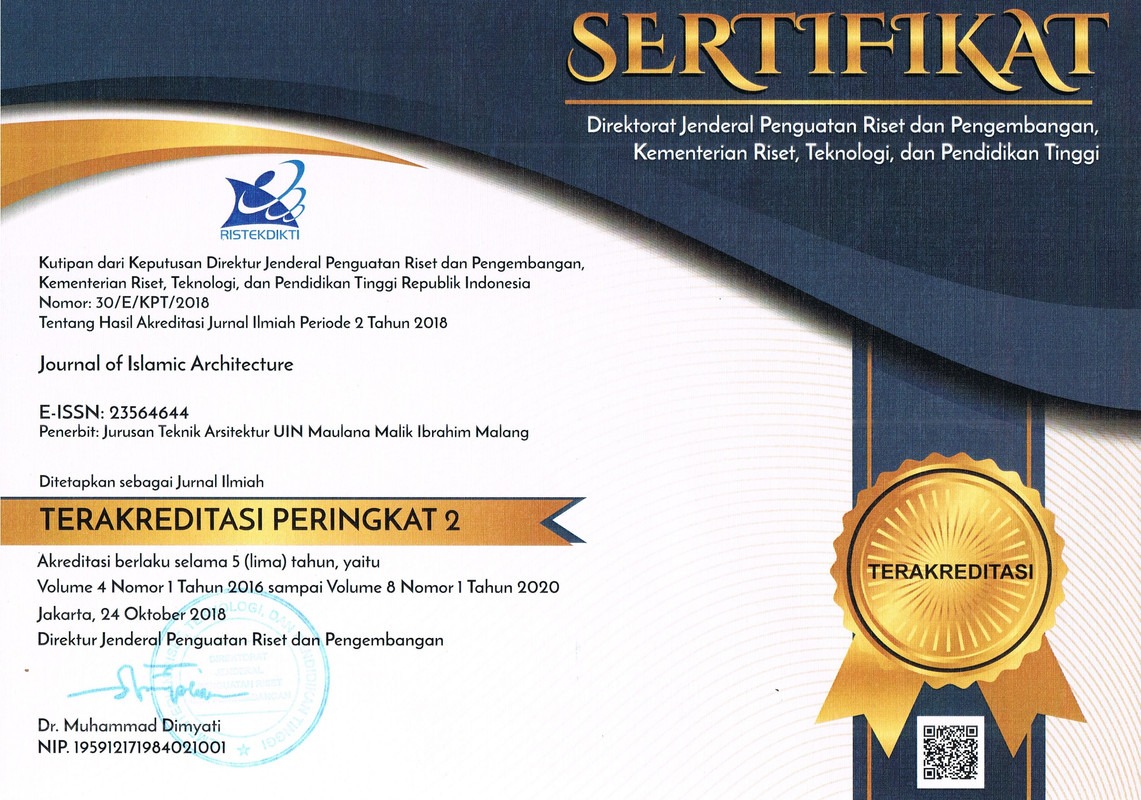LIGHTING DESIGN FRAMEWORK; RECOMMENDATION STUDY FOR NEWCASTLE MOSQUE, NEW SOUTH WALES
Abstract
This research explores the analysis method of the current situation and injects direct design proposal analysis to the mosque from the existing condition. The exploration of lighting fundamentally and significantly impacts holistic and ritual performance in any religious building. However, regarding the conversion of typology to the mosque, there were a few research that focus on the existing condition in lighting design performance for Newcastle Mosque. Therefore, this study explores approximately four designs of three-dimensional recommendations as a methodology which include passive and active design implications used recorded as part of the discussion. The result shows that the proposed design helped in repairing the conditions of the mosque through the implementation of the skylight, curtain, designated window, and sunbreak for the best rectification recommendation. Furthermore, the result of the study suggests such minimum glare and effective lighting distribution contribute to the amount reduction of energy consumption, improve the quality of reading, and properly enlighten the religious congregational activities and other exercises carried out to optimum brightness of the mosque.
Keywords
Full Text:
PDFReferences
N. ‘Athiqah Baharudin and A. S. Ismail, “Communal Mosques: Design Functionality towards the Development of Sustainability for Community,” Procedia - Social and Behavioral Sciences, vol. 153, pp. 106–120, Oct. 2014, doi: 10.1016/j.sbspro.2014.10.046.
R. Abdollahi, “Design of lighting system for sacred places with the approach of improving technical and economic conditions,” Ain Shams Engineering Journal, vol. 12, no. 3, pp. 2899–2905, Sep. 2021, doi: 10.1016/j.asej.2021.02.021.
I. I. El-Darwish and R. A. El- Gendy, “The role of fenestration in promoting daylight performance. The mosques of Alexandria since the 19th century,” Alexandria Engineering Journal, vol. 55, no. 4, pp. 3185–3193, Dec. 2016, doi: 10.1016/j.aej.2016.08.006.
R. Abdollahi, “Design of lighting system for sacred places with the approach of improving technical and economic conditions,” Ain Shams Engineering Journal, vol. 12, no. 3, pp. 2899–2905, Sep. 2021, doi: 10.1016/j.asej.2021.02.021.
F. H. Abdullah, N. H. A. Majid, and R. Othman, “Defining Issue of Thermal Comfort Control through Urban Mosque Façade Design,” Procedia - Social and Behavioral Sciences, vol. 234, pp. 416–423, Oct. 2016, doi: 10.1016/j.sbspro.2016.10.259.
A. S. Hassan and Y. Arab, “Analysis of Lighting Performance between Single Dome and Pyramid Roof Mosque in Mostar, Bosnia Herzegovina,” Procedia - Social and Behavioral Sciences, vol. 91, pp. 1–12, Oct. 2013, doi: 10.1016/j.sbspro.2013.08.395.
M. K. M. Ghodya, Y. Abd-Elkader Azzam, and I. El-Sayed Maarouf, “Strategy of integrating Egyptian sites into world heritage property: Rashid city as a case study,” Ain Shams Engineering Journal, vol. 12, no. 3, pp. 3381–3387, Sep. 2021, doi: 10.1016/j.asej.2020.11.021.
A. Yüksel, M. Arıcı, M. Krajčík, M. Civan, and H. Karabay, “Energy consumption, thermal comfort, and indoor air quality in mosques: Impact of Covid-19 measures,” Journal of Cleaner Production, vol. 354, p. 131726, Jun. 2022, doi: 10.1016/j.jclepro.2022.131726.
M. Alwetaishi et al., “An investigation of shading devices in a hot region: A case study in a school building,” Ain Shams Engineering Journal, vol. 12, no. 3, pp. 3229–3239, Sep. 2021, doi: 10.1016/j.asej.2021.02.008.
Z. Yu, F. Lu, Y. Zou, and X. Yang, “Quantifying the flexibility of lighting systems by optimal control in commercial buildings: Insight from a case study,” Energy and Buildings, vol. 225, p. 110310, Oct. 2020, doi: 10.1016/j.enbuild.2020.110310.
A. M. Abdelbaki, “Selecting the most suitable pedotransfer functions for estimating saturated hydraulic conductivity according to the available soil inputs,” Ain Shams Engineering Journal, vol. 12, no. 3, pp. 2603–2615, Sep. 2021, doi: 10.1016/j.asej.2021.01.030.
M. Parsaee, C. M. H. Demers, J.-F. Lalonde, A. Potvin, M. Inanici, and M. Hébert, “Human-centric lighting performance of shading panels in architecture: A benchmarking study with lab-scale physical models under real skies,” Solar Energy, vol. 204, pp. 354–368, Jul. 2020, doi: 10.1016/j.solener.2020.04.088.
T. W. Kruisselbrink, R. Dangol, and E. J. van Loenen, “A comparative study between two algorithms for luminance-based lighting control,” Energy and Buildings, vol. 228, p. 110429, Dec. 2020, doi: 10.1016/j.enbuild.2020.110429.
C. B. Linander, T. Kallemose, L. M. Joergensen, O. Andersen, J. O. Nehlin, and B. N. Jawad, “The effect of circadian-adjusted LED-based lighting on sleep, daytime sleepiness and biomarkers of inflammation in a randomized controlled cross-over trial by pragmatic design in elderly care home dwellers,” Archives of Gerontology and Geriatrics, vol. 91, p. 104223, Nov. 2020, doi: 10.1016/j.archger.2020.104223.
P. Lassandro, C. S. Fioriello, M. Lepore, and M. Zonno, “Analysing, modeling and promoting tangible and intangible values of building heritage with historic flame lighting system,” Journal of Cultural Heritage, vol. 47, pp. 166–179, Jan. 2021, doi: 10.1016/j.culher.2020.09.013.
S. T. Peeters, K. C. H. J. Smolders, and Y. A. W. de Kort, “What you set is (not) what you get: How a light intervention in the field translates to personal light exposure,” Building and Environment, vol. 185, p. 107288, Nov. 2020, doi: 10.1016/j.buildenv.2020.107288.
DOI: https://doi.org/10.18860/jia.v7i1.13093
Refbacks
- There are currently no refbacks.






